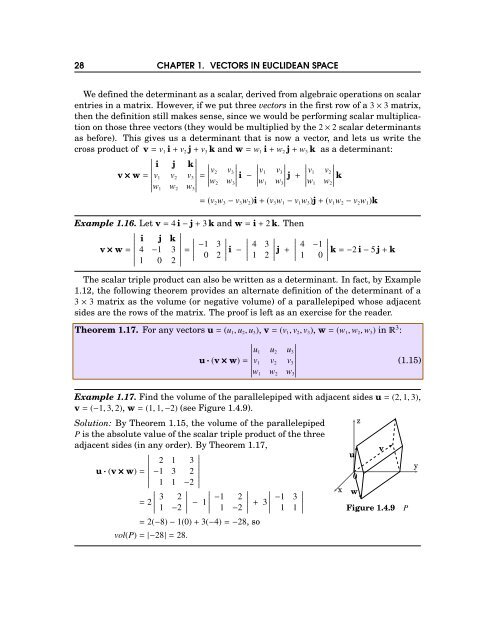Michael Corral: Vector Calculus
Michael Corral: Vector Calculus
Michael Corral: Vector Calculus
Create successful ePaper yourself
Turn your PDF publications into a flip-book with our unique Google optimized e-Paper software.
28 CHAPTER 1. VECTORS IN EUCLIDEAN SPACE<br />
We defined the determinant as a scalar, derived from algebraic operations on scalar<br />
entries in a matrix. However, if we put three vectors in the first row of a 3×3 matrix,<br />
then the definition still makes sense, since we would be performing scalar multiplication<br />
on those three vectors (they would be multiplied by the 2×2 scalar determinants<br />
as before). This gives us a determinant that is now a vector, and lets us write the<br />
cross product of v=v 1 i+v 2 j+v 3 k and w=w 1 i+w 2 j+w 3 k as a determinant:<br />
∣ i j k ∣∣∣∣∣∣∣∣ ∣<br />
v×w=<br />
v 1 v 2 v 3 =<br />
v 2 v ∣∣∣∣∣ ∣<br />
3<br />
i −<br />
v 1 v ∣∣∣∣∣ ∣<br />
3<br />
∣w ∣w 1 w 2 w<br />
2 w j+<br />
v 1 v ∣∣∣∣∣<br />
2<br />
3 ∣w 1 w k<br />
3 ∣w 1 w 2<br />
3<br />
= (v 2 w 3 −v 3 w 2 )i+(v 3 w 1 −v 1 w 3 )j+(v 1 w 2 −v 2 w 1 )k<br />
Example 1.16. Let v=4i−j+3k and w=i+2k. Then<br />
i j k<br />
v×w=<br />
4 −1 3<br />
=<br />
−1 3<br />
∣ ∣∣∣∣∣ ∣ 1 0 2<br />
∣ 0 2<br />
∣ i − 4 3<br />
∣ ∣∣∣∣∣ 1 2<br />
∣ j + 4 −1<br />
1 0<br />
∣<br />
∣ k=−2i−5j+k<br />
The scalar triple product can also be written as a determinant. In fact, by Example<br />
1.12, the following theorem provides an alternate definition of the determinant of a<br />
3×3 matrix as the volume (or negative volume) of a parallelepiped whose adjacent<br />
sides are the rows of the matrix. The proof is left as an exercise for the reader.<br />
Theorem 1.17. For any vectors u=(u 1 ,u 2 ,u 3 ), v=(v 1 ,v 2 ,v 3 ), w=(w 1 ,w 2 ,w 3 ) in 3 :<br />
∣ u 1 u 2 u ∣∣∣∣∣∣∣∣<br />
3<br />
u·(v×w)=<br />
v 1 v 2 v 3<br />
(1.15)<br />
∣w 1 w 2 w 3<br />
Example 1.17. Find the volume of the parallelepiped with adjacent sides u=(2,1,3),<br />
v=(−1,3,2), w=(1,1,−2) (see Figure 1.4.9).<br />
Solution: By Theorem 1.15, the volume of the parallelepiped<br />
P is the absolute value of the scalar triple product of the three<br />
adjacent sides (in any order). By Theorem 1.17,<br />
u·(v×w)=<br />
∣<br />
= 2<br />
∣<br />
2 1 3<br />
−1 3 2<br />
1 1 −2<br />
3 2<br />
1 −2<br />
∣<br />
− 1<br />
∣<br />
∣<br />
−1 2<br />
1 −2<br />
+ 3<br />
∣<br />
∣<br />
= 2(−8)−1(0)+3(−4)=−28, so<br />
vol(P)=|−28|=28.<br />
−1 3<br />
1 1<br />
∣<br />
x<br />
u<br />
0<br />
w<br />
z<br />
v<br />
Figure 1.4.9 P<br />
y








